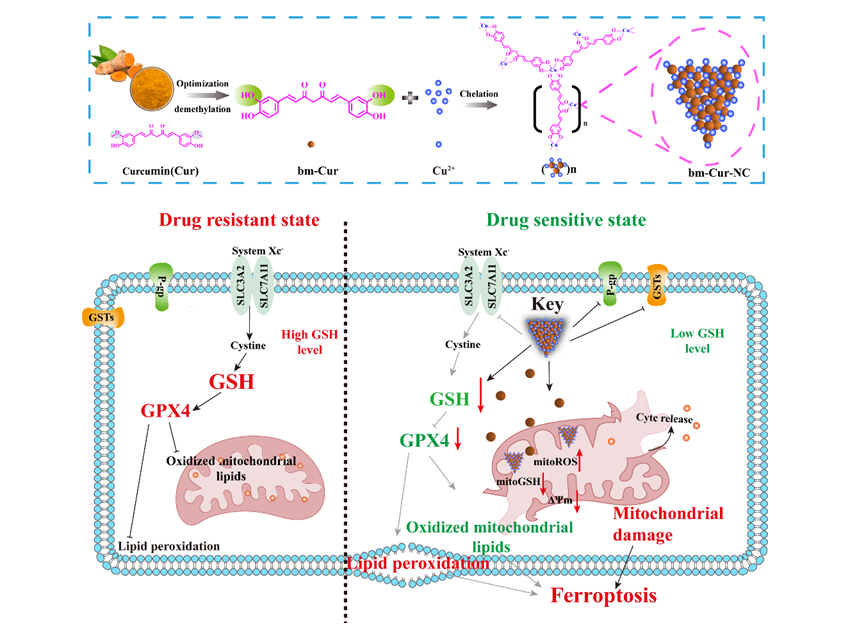Qing He, Fujian I Hunan University, China, Bin Liu, Hunan University, China, Yan Qin, Hunan University of Chinese Medicine, China, and colleagues have engineered a supramolecular nanocomposite (bm–Cur–NC) by coordinating bisdemethylcurcumin—a demethoxylated curcumin derivative—with Cu(II) ions.
The resulting flake-like nanostructure shows excellent water solubility and stability, as well as mitochondrial affinity, offering dual-site activity against the cytoplasmic and mitochondrial compartments of cancer cells. This is the first nanomedicine capable of depleting intracellular glutathione (GSH) through three distinct yet synergistic pathways. By concurrently disrupting redox homeostasis in both the cytoplasm and mitochondria, this system triggers a powerful ferroptotic response in drug-resistant cancer cells.
Breaking Cancer’s Redox Defense
Drug-resistant cancer cells are often fortified with high levels of intracellular GSH, enabling them to neutralize oxidative stress and evade ferroptosis. To combat this, bm–Cur–NC blocks GSH biosynthesis by downregulating the transporter SLC7A11, chemically consumes GSH via Cu(II)-mediated redox cycling, and further depletes it through Michael addition reactions with the polyphenolic backbone.
The depletion of GSH not only triggers lipid peroxidation—a hallmark of ferroptosis—but also disrupts mitochondrial function, as evidenced by membrane potential collapse and elevated hydroxyl radical levels in treated cells.
Efficacy Across Models
The therapeutic potential of bm–Cur–NC was demonstrated in vitro using cisplatin-resistant HepG2/DDP cells and further validated in vivo, where the nanocomplex significantly suppressed tumor growth and prolonged survival in a mouse model.
Importantly, co-treatment with ferroptosis and apoptosis inhibitors confirmed that the dominant mode of cell death was ferroptosis, with a modest contribution from apoptosis.
In addition to hepatocellular carcinoma (HCC), the nanocomposite showed potent cytotoxicity against other drug-resistant cancer lines, including A2780/DDP (ovarian) and MCF-7/ADR (breast), underscoring its broad-spectrum anti-resistance potential.
A Supramolecular Leap Toward Redox Medicine
By uniting the principles of natural product chemistry, supramolecular chemistry, and chemical biology, this study presents a blueprint for next-generation nanotherapeutics. The work highlights how a carefully engineered supramolecular nanocomposite can overcome conventional drug-resistance mechanisms by orchestrating multiple glutathione-depletion pathways and inducing ferroptosis.
Beyond its immediate therapeutic implications, the innovation underscores the transformative potential of supramolecular chemistry in redox medicine and paves the way for precision-designed ferroptotic strategies in cancer treatment, the researchers say.
- Natural Polyphenol–Metal Supramolecular Nanocomplex for Ferroptosis Activation in Chemoresistant Hepatocellular Carcinoma
Yan Qin, Jialong Fan, Yi Zhang, Wei Yang, Jianzhong Cao, Bin Liu, Qing He
Aggregate 2025
https://doi.org/10.1002/agt2.70149



